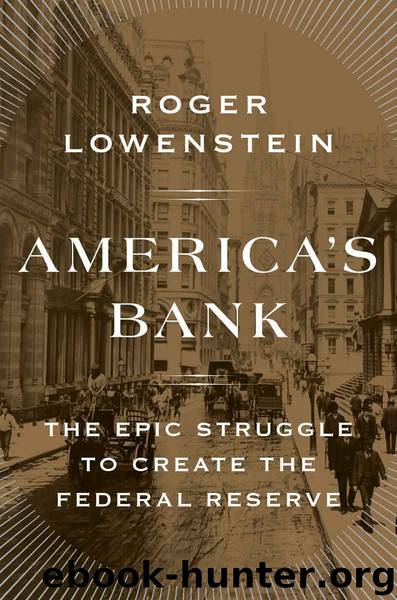America's Bank: The Epic Struggle to Create the Federal Reserve by Roger Lowenstein

Author:Roger Lowenstein [Lowenstein, Roger]
Language: eng
Format: epub, azw3
Publisher: Penguin Publishing Group
Published: 2015-10-20T02:00:00+00:00
It is not like the tariff, about which opinion has been forming long years through. There are almost as many judgments as there are men. To form a single plan and a single intention about it seems at times a task so various and so elusive that it is hard to keep one’s heart from failing.
Presenting the legislation, Wilson broke with tradition again. On June 23, formally got up in black frock coat, gray trousers, and a dark cravat, the President returned to the Capitol. His wife and two of their daughters were seated in the President’s pew. Speaker of the House Champ Clark (whom Wilson had bested at the Democratic convention) rapped his gavel, and Wilson, accompanied by Secret Service men, entered from a doorway in the rear. All rose, he ascended the rostrum, and Clark announced the President of the United States. Wilson read his speech, nodding on occasional words for emphasis. It took only nine minutes. He stressed—fittingly, on such a sweltering afternoon—that the hardship of working through the “heated season” was no excuse for delay. “We must act now,” he said, snapping his jaws at the word, “at whatever sacrifice to ourselves.”
Wilson depicted banking reform as a companion to still pending tariff reductions—together, the two measures would set business free from the twin shackles of arbitrary duties and inadequate credit. He cited three principles for banking reform. One was the cliché that the currency should be “elastic,” by which he meant flexible in quantity, to meet the ebb and flow of demand. Another echoed Warburg: “Our banking laws must mobilize reserves,” Wilson said. And this, he asserted, would accomplish a third purpose—abolishing the concentration of monetary resources “in [just] a few hands.” Banks, Wilson concluded ringingly, should be the instruments and not the masters of business.
• • •
THE AMERICAN BANKERS ASSOCIATION, members of whose currency commission were conveniently meeting in New York, at the Waldorf Hotel, now went on a counterattack. The view of midwestern bankers, including James Forgan, president of the First National Bank of Chicago, was emphatically negative. Bankers had urged reform for years; now that it looked as though reform could bring about federal control, they were not so happy.
Bankers generally applauded the aspect of individual Reserve Banks, which Willis had designed to be owned by banks and run by bankers—so-called bankers’ banks. However, La Salle Street was uncomfortable with the central board—a public body—and unsettled that the Glass bill authorized Washington to determine the key interest rate, known as the discount rate, in each district.
Many bankers also objected to the compulsory shifting of reserves. Country banks would lose the interest they collected from depositing funds in banks in the city; city banks would lose control of the money. Breaking this dependent relationship was, of course, one of the primary purposes of the legislation. The goal was to establish collective reserves to replace the archaic pattern of every bank for itself. In practice, many bankers treated their vault reserves as a drug that—however harmful in theory—was impossible to give up.
Download
America's Bank: The Epic Struggle to Create the Federal Reserve by Roger Lowenstein.azw3
This site does not store any files on its server. We only index and link to content provided by other sites. Please contact the content providers to delete copyright contents if any and email us, we'll remove relevant links or contents immediately.
International Integration of the Brazilian Economy by Elias C. Grivoyannis(91342)
The Radium Girls by Kate Moore(11922)
Turbulence by E. J. Noyes(7937)
Nudge - Improving Decisions about Health, Wealth, and Happiness by Thaler Sunstein(7619)
The Black Swan by Nassim Nicholas Taleb(7012)
Rich Dad Poor Dad by Robert T. Kiyosaki(6411)
Pioneering Portfolio Management by David F. Swensen(6227)
Man-made Catastrophes and Risk Information Concealment by Dmitry Chernov & Didier Sornette(5922)
Zero to One by Peter Thiel(5689)
Secrecy World by Jake Bernstein(4647)
Millionaire: The Philanderer, Gambler, and Duelist Who Invented Modern Finance by Janet Gleeson(4379)
The Age of Surveillance Capitalism by Shoshana Zuboff(4211)
Skin in the Game by Nassim Nicholas Taleb(4163)
Bullshit Jobs by David Graeber(4096)
The Money Culture by Michael Lewis(4078)
Skin in the Game: Hidden Asymmetries in Daily Life by Nassim Nicholas Taleb(3930)
The Dhandho Investor by Mohnish Pabrai(3701)
The Wisdom of Finance by Mihir Desai(3655)
Blockchain Basics by Daniel Drescher(3509)
